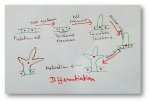Disposal of Liquid Wastes and Solid Wastes
We will discuss here about the disposal of liquid wastes and solid wastes.
What are the ways we can dispose liquid wastes?
If domestic liquid wastes are allowed to flow here and there or to collect in small pits or puddles near the house, the surroundings become dirty. In that dirty water of the puddles, mosquitoes lay eggs and a large number of mosquitoes are produced. They cause malaria and other diseases. So if we waste water, it must be disposed of properly.
All waste water from the houses should be led to pits through covered drains. There are different other ways of disposal of waste water too. Liquid wastes from places like bathroom, kitchen and latrine can be carried to a kitchen garden through drains to irrigate the plants there.
In big cities there is a proper underground sewage disposal
system. Sewage is the name given to the wastes produced by human beings in the
form of faeces and urine. The sewage and waste water are disposed of through
the underground sewage system. Houses in a city mostly have sanitary latrines
or flush latrines which are connected to the system. So faeces and urine
directly go away from the latrine seat.
What are the ways we can dispose solid wastes?
There are many kinds of solid wastes in our houses and surroundings. For example vegetable peels, left-over food, decaying plants and animals, dry leaves, waste paper and plastic etc. These waste produce germs and attracts flies which also carry germs. These germs spread diseases like diarrhoea, dysentery, typhoid, cholera, etc.
These diseases can be prevented by keeping our homes and surroundings clean. The garbage of solid wastes should not be allowed to pile up and decay. Domestic garbage should be collected in dustbins having lids and be dumped at a proper place or in a compost pit.
We can make a compost pit and we should place our daily garbage into the pit.
When the pit is full, it is covered with a layer of soil. The garbage lying therein decays after sometimes and turns into manure.
Animal dung may be used to make bio-gas. Newspapers and paper wastes can be used to make pulp. This pulp is utilised for making fresh paper. Vegetable peels and left over food may be given to the domestic animals to eat. Plastic bags can be utilised to throw away the domestic wastes. Empty bottles, fused bulbs etc. may be utilised to make something decorative or useful.
From Disposal of Liquid Wastes and Solid Wastes to HOME PAGE
Recent Articles
-
Differentiation, Dedifferentiation and Redifferentiation | Definition
Apr 21, 25 01:16 PM
Cells from the root apical meristem and shoot apical meristem the camera that differentiate , mature to perform different functions. This process by which the cells undergo different major structural… -
Explain about Growth in Plants |Definition of Growth & Differentiation
Feb 27, 25 02:07 PM
Growth is a permanent increase in length or volume of an organism that brought upon by an increase in its dimensions due to synthesis of new protoplasmic material. -
Definition of Respiratory Quotient | calculation | Application | Plant
Dec 02, 24 12:09 AM
Definition of respiration quotient- the ratio of the carbon-dioxide evolved to that of the oxygen consumed by a cell, tissue, plants or animals in a given time is called respiratory quotient. It is us… -
Amphibolic Pathway | Definition | Examples | Pentose Phosphate Pathway
Jun 06, 24 10:40 AM
Definition of amphibolic pathway- Amphibolic pathway is a biochemical pathway where anabolism and catabolism are both combined together. Examples of amphibolic pathway- there are different biochemical… -
Respiratory Balance Sheet | TCA Cycle | ATP Consumption Process
Feb 18, 24 01:56 PM
The major component that produced during the photosynthesis is Glucose which is further metabolised by the different metabolic pathways like glycolysis, Krebs cycle, TCA cycle and produces energy whic…




New! Comments
Have your say about what you just read! Leave me a comment in the box below.